Introduction
The Oxford Dictionary's first record of the word workhouse dates back to 1652 in Exeter — 'The said house to bee converted for a workhouse for the poore of this cittye and also a house of correction for the vagrant and disorderly people within this cittye.' However, workhouses were around even before that — in 1631 the Mayor of Abingdon reported that "wee haue erected wthn our borough a workehouse to sett poore people to worke"
Support for the poor from the public purse is often dated from the end of Queen Elizabeth's reign in 1601 when the passing of an Act for the Relief of the Poor made parishes legally responsible for looking after their own poor inhabitants. This was funded by the collection of the poor rates — a tax on local property owners that eventually evolved into "the rates", now the present-day "council tax". The 1601 Act made no mention of workhouses although it provided that materials should be bought to provide work for the unemployed able-bodied relief claimants, with the threat of prison for those who refused. It also proposed the erection of housing for the "impotent poor" — the elderly, chronic sick, etc.
Parish poor relief was dispensed mostly through "out-relief" — handouts of money, clothing, food, or fuel, to those living in their own homes. This could include regular pension-style payments to the elderly. However, the workhouse gradually began to evolve in the seventeenth century as the alternative option of "indoor relief", both to save the parish money, and also as a deterrent to the able-bodied who could be required to work, usually without pay, in return for their board and lodging. The passing of the Workhouse Test Act in 1723, gave parishes the option of denying out-relief and offering claimants only the workhouse.
Parish workhouse buildings were often just ordinary local houses, rented for the purpose. Sometimes a workhouse was purpose-built, like this one erected in 1729 for the parishes of Box and Ditteridge in Wiltshire.
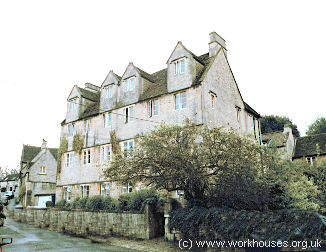
Parish workhouse, Box, Wiltshire.
© Peter Higginbotham.
In some parishes, the poor were "farmed", with the running of the workhouse being handed over to a private contractor who was paid either a fixed annual sum, or a more frequent sum based on the number of inmates. The contractor also got the benefit of any income-generating work done by the paupers. The parish workhouse was not, however, necessarily regarded as place of punishment, or even privation. Indeed, conditions could be pleasant enough to earn some institutions the nickname of "Pauper Palaces".
Not all parishes operated a workhouse, however. A national survey in the 1770s found that around 2,000 of the 15,000 or so parishes in England and Wales — around 1 in 7 — were doing so. The great majority were supporting their poor only through out-relief, or by accommodating the impotent poor in parish-provided housing, sometimes known as poorhouses, though the distinction between the terms workhouse and poorhouse is sometimes rather blurred.
Gilbert's Act of 1782 simplified and standardized the procedures for parishes to set up and run workhouses, either on their own, or by forming a group of parishes called a Gilbert Union. Under Gilbert's scheme, able-bodied adult paupers would not be admitted to the workhouse, but were to be maintained by their parish until work could be found for them. Although relatively few workhouses were set up under Gilbert's scheme, the practice of supplementing labourers' wages out of the poor rate did become widely established. The best known example of this was the "Speenhamland System" which supplemented wages on a sliding scale linked to the price of bread and family size.
At the start of the nineteenth century, the nationwide cost of poor relief, which was predominantly out-relief, was beginning to spiral. This was due to factors such as bad harvests, the Napoleonic wars, the introduction of the Corn Laws, the use of wage support, and inefficiencies and corruption in parish relief administration. Many believed that parish relief had become seen as an easy option by those who did not want to work. There was also growing civil unrest during this period, culminating in the Captain Swing riots whose targets included workhouses. In 1832, the Government set up a Royal Commission to investigate the problems and propose changes.
In 1834, the Commission's report resulted in the Poor Law Amendment Act which was intended to end to all out-relief for the able-bodied. The parishes in England and Wales were formed into groups known as Poor Law Unions — typically twenty or thirty parishes, around a market town. Each union was to have its own large workhouse to serve the whole union area. A similar scheme was introduced in Ireland in 1838, while in 1845 Scotland set up a separate and somewhat different system.
Each Poor Law Union was managed by a locally elected Board of Guardians and the whole system was administered by a central Poor Law Commission. In the late 1830s, hundreds of new union workhouse buildings were erected across the country. The Commission's original proposal to have separate establishments for different types of pauper (the old, the able-bodied, children etc.) was soon abandoned and a single "general mixed workhouse" became the norm. The new buildings were specially designed to segregate the different categories of inmate. The first purpose-built workhouse to be erected under the new scheme was at Abingdon in 1835.
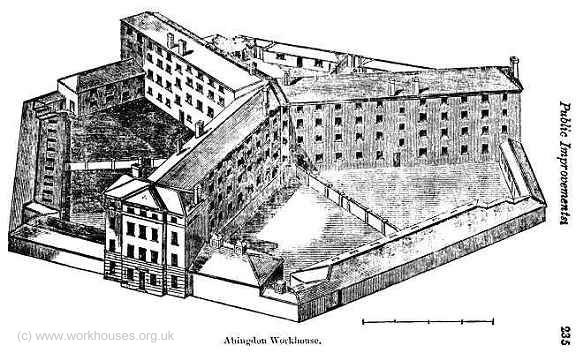
Abingdon Union workhouse, 1835.
©Peter Higginbotham

The former Andover Union workhouse, erected in 1836.
© Peter Higginbotham.
For the next century, the Union Workhouse was in many localities one of the largest and most significant buildings in the area, the biggest accommodating more than a thousand inmates. Liverpool's massive workhouse could house over three thousand. The Liverpool Metropolitan (RC) Cathedral now occupies the site.
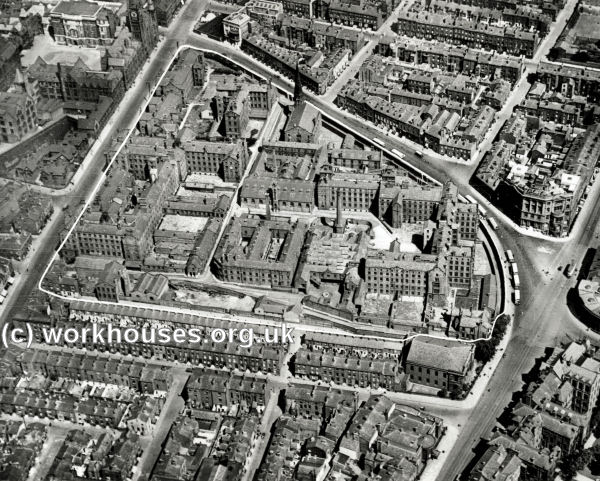
Aerial view of Liverpool workhouse
© Peter Higginbotham.
Under the 1834 Act, the threat of the Union workhouse was intended to act as a deterrent to the able-bodied pauper. This was a principle enshrined in the revival of the "workhouse test" — poor relief would only be granted to those desperate enough to face entering the workhouse. If an able-bodied man entered the workhouse, his whole family had to enter with him. However, people were not "put" in the workhouse or "sent" to the workhouse, rather they were offered the workhouse, or resorted to it if they had no other practical option.
Life inside the union workhouse was was intended to be off-putting. Men, women, children, the infirm, and the able-bodied were housed separately and given very basic and monotonous food such as gruel (thin porridge) or bread and cheese. All inmates had to wear workhouse clothing and sleep in communal dormitories. Supervised baths were given once a week. The able-bodied were given hard work — for men this could include oakum picking (teasing apart old ropes into their raw fibres) and stone-breaking, while women performed domestic labour such as cleaning and laundry work. The elderly and infirm did not have to work but had little else to do than sit around in the day-rooms or sick-wards with little opportunity for visitors. Parents were only allowed limited contact with their children — perhaps for an hour or so a week on Sunday afternoon.
By the 1850s, the majority of those entering the workhouse were not the work-shy, but the old, the infirm, the orphaned, unmarried mothers, and the physically or mentally ill. The workhouse was not, however, a prison. People could, in principle, leave whenever they wished, for example when work became available locally. Some people, known as the "ins and outs", entered and left quite frequently, treating the workhouse almost like a guest-house, albeit one with the most basic of facilities. For some, however, their stay in the workhouse would be for the rest of their lives.
In the 1850s and 60s, complaints were growing about the conditions in many London workhouses. Figures such as Florence Nightingale, Louisa Twining, and the medical journal The Lancet, were particularly critical of the treatment of the sick in workhouses which was frequently in insanitary conditions and with most of the nursing care provided by untrained and often illiterate female inmates. Eventually, parliament passed the Metropolitan Poor Act which required workhouse hospitals to be on sites separate from the workhouse. The Metropolitan Asylums Board (MAB) was also set up to look after London's poor suffering from infectious diseases or mental disability. The smallpox and fever hospitals set up by the MAB were eventually opened up to all London's inhabitants and became the country's first state hospitals. Similar developments gradually took place across the country, with the sick poor increasingly referred for treatment in their union infirmary without having to first be a workhouse inmate. In many places, the workhouse infirmary became the local free hospital for those unable to pay for private medical care, so laying the foundations for Britain's National Health Service which began in 1948.

Holborn Union Infirmary, 2003
© Peter Higginbotham.
As well as local union residents, workhouses provided one or two nights' accommodation for passing tramps, vagrants or other destitute travellers. Most workhouses erected a special building for the purpose known as the casual ward. As in the main workhouse, able-bodied inmates of the casual ward were required to work in return for their board and lodging, again with oakum picking and stone breaking being common activities.
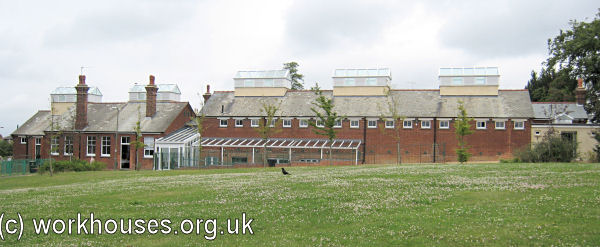
Former Guildford workhouse casual ward, 2005.
© Peter Higginbotham.
Towards the end of the nineteenth century, conditions steadily improved in the workhouse, particularly for the elderly and infirm, and for children. Small luxuries such as books, newspapers, and even occasional outings to the countryside or seaside were organised. Food became more varied — the 1901 Manual of Workhouse Cookery included recipes for treats such as Irish stew, shepherd's pie and roly-poly pudding.
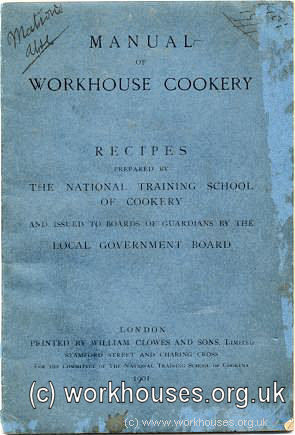
Workhouse cookery book, 1901.
© Peter Higginbotham.
From the 1840s, children were increasingly housed away from what was viewed as the "taint" of the workhouse, in separate accommodation such as cottage homes, which were often placed out in the countryside.
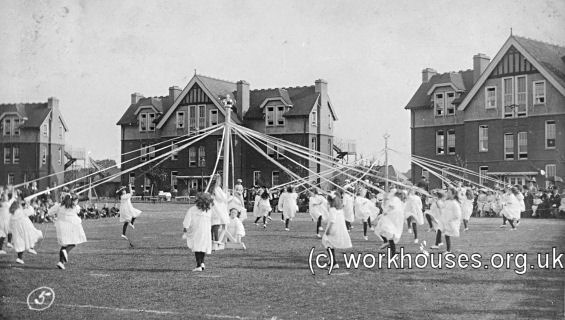
Hackney cottage homes sports and inspection day, 1913.
© Peter Higginbotham.
On 1st April 1930, when the 643 Boards of Guardians in England and Wales were abolished and their responsibilities passed to local authorities. Some workhouse buildings were sold off, demolished, or fell into disuse. Most, however, became Public Assistance Institutions and continued to provide accommodation for the elderly, chronic sick, unmarried mothers and vagrants. For inmates of these institutions, life often changed relatively little during the 1930s and 40s. Apart from the abolition of institutional clothing, and more freedom to come and go, things improved only slowly.
With the introduction of the National Health Service in 1948, many former workhouse buildings joined the NHS and continued to house the elderly and chronic sick. Others were retained by local councils as old people's homes. Many of the old buildings have since been demolished. The survivors have increasingly been sold off for redevelopment, ironically, in some cases, as luxury residential accommodation.
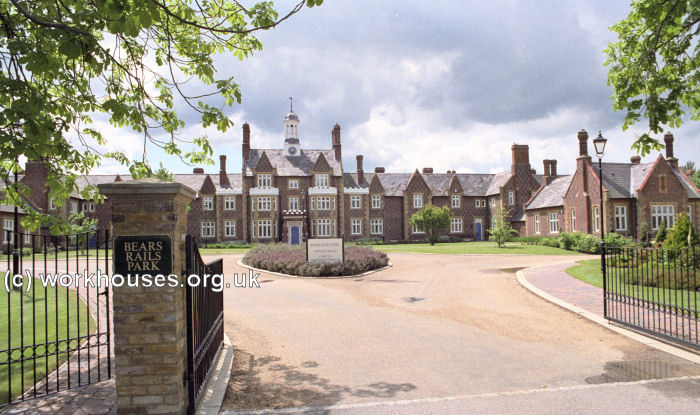
The former Windsor workhouse, now in private residential use.
© Peter Higginbotham.
Increasingly little remains of these once great and gloomy edifices. What does survive often passes unnoticed. But even now, many decades after its disappearance, the mere mention of the workhouse can still send a shiver through those old enough to remember its existence. In Kendal, the location of a long-gone parish poorhouse or workhouse is modestly marked in a now renamed side-road. However, some local residents clearly feel this is an institution they would rather not commemorate...
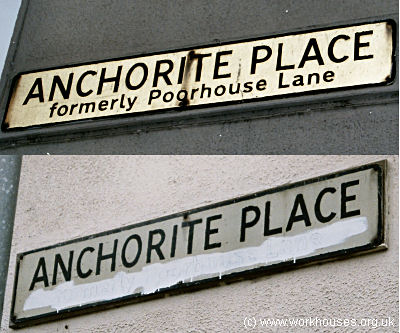
Kendal road signs, 2004
© Peter Higginbotham.
For more information about every facet of the workhouse, please explore the rest of this web-site. If you can't find what you need, try typing a word or a phrase (in quotes) into the Search box near the top of any page.
Unless otherwise indicated, this page () is copyright Peter Higginbotham. Contents may not be reproduced without permission.


